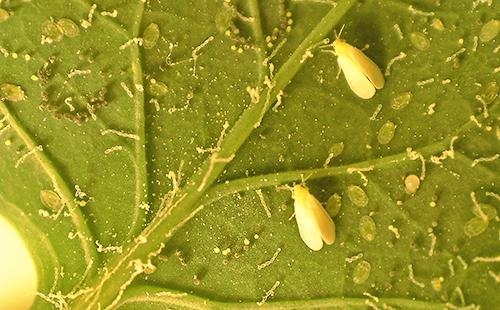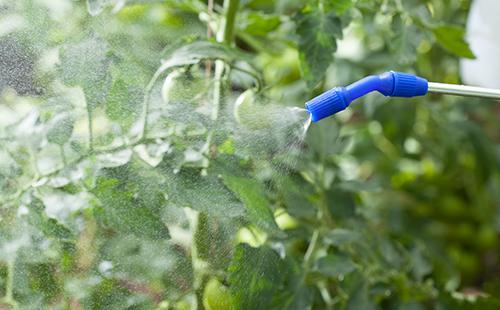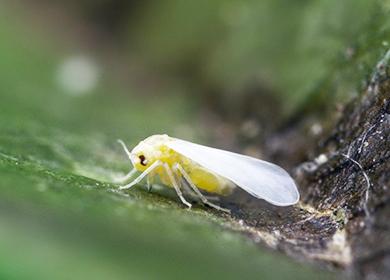The content of the article
To make sure that your whitefly attacked your plants at home, for example, geraniums, the description and photo of the pest will help. But the methods of getting rid of it, how to remove an insect and treat plants from phytopathogenic viruses, the carrier of which is this pest - we will prompt in our article. And it’s up to you to decide which remedy is most suitable for you and why.
Pests hide on the underside of the leaves - until the insects breed, it is difficult to notice them. Gradually, small white butterflies begin to attack all the flowers in the house. To prevent this, indoor plants need to be inspected periodically.
Description of the flying pest
The whitefly on the flowers looks harmless, but it does great harm to plants. Outwardly, it looks like a small moth. Whiteflies can be recognized by white wings covered with a powdery powdery coating. The body length of the insect is no more than 2-3 mm.
Whiteflies hide on the underside of the leaves, leaving clutches of eggs in the same place. The danger comes mainly from the larvae - they feed on the sap of the plant, leading to its death. One female lays about 300 eggs per month. The life span of an insect is about a month.
Whiteflies are carriers of dangerous viral and infectious diseases. Due to the rapid reproduction and ability to fly, it is difficult to remove the whitefly. If at least one insect has been noticed on the plant, it is necessary to carry out the treatment as soon as possible, carefully examine all the flowers in the house.
Insect life cycle
The whitefly development cycle from an egg to an adult insect lasts from one and a half to three months, depending on conditions and air temperature. The insect forms in six stages.
- First stage. An adult female lays eggs on the underside of the upper leaves. The stage lasts from 11 to 22 days.
- Second stage. A brown or black caterpillar emerges from the egg. She is very small, mobile. Caterpillars live on the underside of the leaf, feed on the sap of the plant. In this state, she stays from a week to 11 days.
- Third stage. Caterpillars turn into motionless larvae. Shape and color do not change - only size. At this stage, the larvae are called nymphs. The stage lasts from five to seven days.
- Fourth stage. The larva remains motionless, retains color and shape, continues to increase in size. Development lasts from one to two weeks.
- Fifth stage. The larva turns into a black oval-shaped pupa. It develops from a week to 34 days.
- Sixth stage. An adult insect hatch from a pupa.
The intensity of development depends on temperature. In heat, the cycle ends quickly, at 10-15 ° C, development stops, at a lower temperature, the whitefly dies.

Signs of infection
The easiest way to recognize a whitefly is to touch a flower. A flock of disturbed insects will rise into the air. The attacked plant begins to hurt. This is manifested in the following signs.
- Yellowing and warping leaves. Larvae feed on plant sap. The leaves are first covered with spots, then turn yellow and deformed.
- Bud drop. In a sick flower, the buds dry and fall off without blooming.
- Honeydew. Leaves are covered with a sticky sugar coating.
- Secondary infections. A sooty fungus settles in the place of plaque. The affected areas are covered with black coating, the leaves fall off.
How to get rid of whiteflies on indoor flowers
Since it is quite difficult to deal with whiteflies on indoor plants, an integrated approach should be used. Florists use drugs, folk remedies, special traps.
Chemicals
To combat whitefly use special drugs - insecticides. With a minor lesion, a single treatment is enough, but more often it is repeated after the time interval specified in the instructions. There are many drugs, but the following are most popular.
- Aktara. Judging by the reviews of flower growers, an effective remedy for whiteflies. The solution is watered on the ground in the root system. Plant juice poisoned by an insecticide leads to mass death of the pest. In advanced cases, in addition to watering, the ground part of the plant is sprayed.
- Confidor. Sold in the form of water-soluble granules. The solution is watered with soil, in case of severe damage, plants are additionally sprayed. It leads to the instant death of whiteflies.
- Tanrek. Sold as a concentrated dilution solution. Used to water the soil around an infected plant. It has a long protective effect - up to a month.
- Akarin. The solution of the drug is used mainly for spraying plants. In addition to whiteflies, the product is effective against aphids, spider mites and other pests of indoor flowers.
- "Actellic". Concentrated dilution solution. It is used to spray indoor flowers with whitefly and other pests.
- Inta-Vir. Sold in the form of water-soluble tablets. Used for spraying. According to the manufacturer, the drug is effective against 52 types of pests.
- Fitoverm. In one or two treatments it kills all larvae and adult insects. Effective insecticide - helps against most pests of indoor flowers.
- Karbofos. An old, time-tested tool. Many newer drugs are made on its basis. It has a wide range of applications, it acts quickly.

Folk remedies
Lesser whitefly larvae on flowers can be destroyed with less toxic substances. Florists use tobacco dust, garlic, mechanical cleaning, exposure to temperature. Pest control with folk remedies should be comprehensive.
- Mechanical cleaning. Plants regularly inspect, wipe the leaves with a damp sponge. If single pests are found, they are immediately destroyed.
- Cold exposure. Whitefly does not tolerate low temperatures.Frost-resistant plants are exposed on the balcony. Adult insects and larvae die, the eggs remain viable - after a while the exposure to cold is repeated.
- Tobacco. From folk remedies, tobacco infusion is considered the most effective. Tobacco from a pack of strong cigarettes is poured with a liter of hot water, insisted for five days, filtered. Indoor flowers are sprayed two to three times a day.
- Dandelion. About 100 g of leaves anddandelion roots crushed, poured with a liter of water, insist four days, filtered. Spray plants at weekly intervals.
- Soap. Soap solution is a common tool in the complex control of whiteflies and other pests of indoor flowers. Laundry soap is rubbed on a fine grater, poured with water. One part of the soap takes six parts of water. The solution wiped the leaves and stems affected by pests.
- Garlic. Three cloves of garlic are rubbed on a fine grater, poured with a liter of water, insist for a day, filtered. The treatment is repeated several times until the pests disappear completely.
- Yarrow. About 100 g of yarrow leaves are crushed, poured with a liter of water, insist for a day, filtered. Sprayed several times, until the whiteflies completely disappear.
- Wood ash. A glass of ash is poured into 5 liters of water, left for three hours. 50 g of diluted laundry soap are added to the infusion. The mixture is treated several times with flowers infected with the pest.
Ready-made and home-made traps
For the extermination of adults use ready-made or home-made traps. Reducing the number of whiteflies helps prevent their spread to other indoor flowers.
- Ready traps. The shops sell special traps to kill pests. They are hung in close proximity to the affected flower.
- Homemade traps. As a basis, they use dense cardboard of bright yellow color - it attracts insects. Any glue that dries for a long time, does not have a pronounced smell, is applied to the surface. Instead of glue, you can use petroleum jelly or castor oil. Traps are hung on the supports installed in the pot.

Preventative measures
Timely preventive measures will minimize the likelihood of whiteflies and other pests. There are six rules to follow.
- Soil sterilization. Before use, the soil mixture is calcined in the oven, watered with a solution of potassium permanganate and fungicide.
- Quarantine Compliance. New plants are set separately from other indoor flowers. During the week, they monitor, if pests are detected, they are treated with an insecticide.
- Pruning and hygiene. The yellowed leaves are cut off in a timely manner, plant residues are removed from the pot. Do not use tea leaves and other food residues as fertilizer.
- The use of stimulants. Increase plant immunity by periodic spraying with growth stimulants. Apply fertilizer regularly.
- Spraying and "bathing". Spray the leaves with soft warm water, periodically wash the plant in the shower. For some flowers, these procedures are contraindicated.
- Ventilation. Do not allow stagnation of air in the room. The room is regularly ventilated, avoiding the formation of drafts.
The fight against whiteflies on indoor plants can drag on for several weeks. It is important to complete the work begun - not only adults and larvae should die, but also egg laying.
Reviews: “I prepare the infusion of garlic and sprinkle them with plants”
I want to share how I got rid of the whitefly. I bought a room pomegranate via the Internet, before that I had a pomegranate, but died from whiteflies. I really hoped that this one would be healthy. And now I receive by New mail, I come home, I begin inspection. And oh god, and here is a whitefly. I can’t poison - the house is a small child, and it’s cold on the balcony. She took washed the leaves and sprayed “Maskitol” from the moth.Top of course clothed a bag. Hold for 3 hours. Then she took off her bag and washed the leaves again. Part of the leaves were affected. Probably should have kept less. But now 10 days have passed and there are no whiteflies. After all, it looks like a moth - so I decided the remedy for the moth. After all, this tool acts on the larvae and is also not toxic to humans. I have been treating him with a fur coat and woolen things for more than a year. It has the smell of lavender. I buy in the department where the funds from mosquitoes and moths are in an aerosol. Already pomegranate launched new leaves. So far, healthy.
Irina, http://vredstop.ru/nasekomye/belokrylka-na-komnatnyx-cvetax.html
I struggle with whiteflies with garlic. I prepare an infusion and spray them with plants. You can also stick a couple of cloves of garlic directly into the ground, and put the same amount on top. Garlic odor scares off many pests, including whiteflies.
Kseniya, https://apest.ru/moshki/belokrylka-na-komnatnyh-rasteniyah-kak-borotsya/#i-2
Against whiteflies, I use traps - rolled cylinders, sticky from the inside. They need to be updated periodically, because many insects stick to them very quickly. If the procedure is done regularly. first adult insects will stick to the traps, followed by the young, who have not yet had time to lay eggs, and there will be no one to lay eggs.
Chantane https://www.botanichka.ru/article/aleyrodidae/

